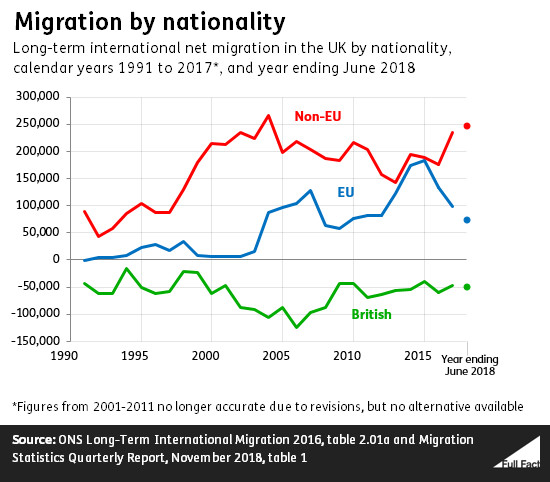A chart from Full Fact:

As such, one (presumed) reason for Brexit - to reduce net migration into the UK - is, we are told, a delusion.
Yet, even if we ignore the doubts that Madeleine Sumption, director of the Migration Observatory at the University of Oxford, has about the numbers, that "Other data sources do not support the idea that non-EU citizens are currently contributing so much to net migration", a closer look at the statistics is instructive.
If we look at the Office for National Statistics's (ONS's) Provisional Long-Term International Migration estimates, we get breakdowns of migration by reason: Work Related (Definite job/Looking for work), Accompany/Join (presumably family reunification), Formal study, Going home to live, Other and No Reason Stated.
One thing that stands out is that 2-4 times as many non-EU as EU migrants go to the UK to study, which will certainly bias the migration numbers. After all, while they are officially counted in the migration numbers, students are not the sort of 'migration' that Brexiters (or indeed, the UK public in general) wants to reduce.
After all, (bona fide) students are not drains on public funds, nor do they compete with locals for jobs. Indeed, non-EU students are especially welcome as they pay higher school fees.
So to have a better idea about migration to the UK that Brexiteers care about (and how the numbers can be reduced), we need to remove students from the total.
The ONS notes that:
"Care should be taken when comparing inflow and outflow by main reason for migration. Returning migrants are asked their reason for returning, not their original reason for migrating. A former immigrant's main reason for leaving the UK may well differ from their previous main reason for immigrating into the UK. Because of this, no balance estimates are displayed. Please see the Notes worksheet for more information."
As such, I will not calculate net migration (i.e. balance estimates), excluding migration for educational purposes, but will just look at inflows.
Looking at the years ending June (since the Brexit vote was held on June 23 2016 and presumably would've affected the data after June), we get:

(also given in HTML format)
| Years Ending/Thousands | EU | Non-EU | EU | Non-EU | EU | Non-EU | EU/Non-EU Ratio |
| Inflow - all reasons | Formal study | Inflow excluding Formal study | |||||
| Jun 11 | 157 | 309 | 45 | 183 | 112 | 126 | 0.89 |
| Jun 12 | 144 | 263 | 39 | 148 | 105 | 115 | 0.91 |
| Jun 13 | 171 | 216 | 28 | 132 | 143 | 84 | 1.70 |
| Jun 14 | 205 | 240 | 39 | 120 | 166 | 120 | 1.38 |
| Jun 15 | 242 | 254 | 47 | 131 | 195 | 123 | 1.59 |
| Jun 16 | 264 | 242 | 34 | 113 | 230 | 129 | 1.78 |
| Jun 17 (anomaly for study) | 210 | 221 | 33 | 94 | 177 | 127 | 1.39 |
| Jun 18 (provisional) | 206 | 293 | 56 | 135 | 150 | 158 | 0.95 |
Clearly, from July 2013 to June 2017, once we exclude students, EU migration has exceeded non-EU migration quite significantly. Thus claiming that non-EU net migration exceeds EU net migration may be technically true but is very misleading.
Of course, after their studies some people will stay on in the UK to work (or do other things).
Yet, this will only increase the ratio of EU to non-EU migration, since ex-students from the EU are easily able to stay on after their studies - while non-EU students are essentially kicked out.


